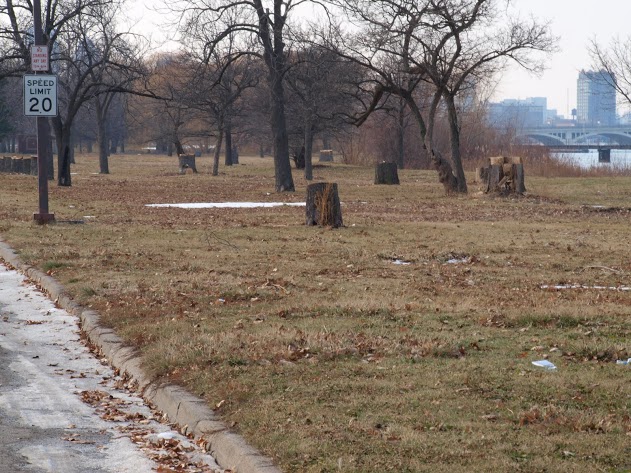All eyes on Belle Isle as state takes control
[flexiblemap src="http://mapsengine.google.com/map/kml?mid=z19qXc0r_Zk8.k6ICuvWezAvE" width=100% maptype=satellite]
Here are some of the improvements, both underway and planned, for Detroit's river park, Belle Isle, as a 30-year state lease begins this year. Red markers indicate work that's either underway or set to begin soon; blue markers are for potential projects with no commitments yet. Click on the markers to read details about each improvement.
Detroit’s Belle Isle, historians will tell you, is an example of the City Beautiful movement, when urban planners looked to ease the troubles of hard-working residents by cultivating pastoral public settings for all to enjoy.
That was a century past, however. Today, the Detroit River island park is about to become a different sort of experiment in urban life – call it State Competence.
On Tuesday, Belle Isle will officially join the state park system, relieving the cash-poor city of $6 million in annual costs. A 30-year lease will make historic-but-rundown Belle Isle the responsibility of the Michigan Department of Natural Resources to operate and improve. It is also an important test of whether the emergency management imposed by Gov. Rick Snyder in 2013 can follow through on its promise to help improve the lives of ordinary Detroiters, ensuring that all eyes will be on the park as snows melt and warm-weather recreation gets underway.
Sarah Earley, who chairs the Belle Isle Conservancy board, knows the stakes are high, but she says she’s not worried.
“The day after the lease was signed, the DNR was in the park,” she said, meeting with longtime volunteers, surveying the facilities and “hammering on trees.” Work began in December, with state workers getting started removing all or parts of more than 160 trees judged unsafe for the park’s picnic areas.
Picnic tables were re-planked, a shelter was re-roofed and a group of young adults with an interest in plumbing trades were invited to help re-plumb a public bathroom – a particular interest of the state as the lease begins, said Ron Olson, DNR spokesman.
The lack of functioning toilets has been an embarrassment for the park, where fiberglass portable toilets have stood outside non-working restrooms for years. Olson said the DNR will also turn its immediate attention to mundane areas like trash disposal, believing that cleanliness is a major factor in attracting visitors.
To that end, the department has started sinking posts that will secure trash barrels against wind and mischief.
“We’ve identified 60 to 80 litter barrels that have blown into lakes and canals that we can see,” and need to be retrieved, said Olson. Now ice-locked, fishing them out will be among the first tasks after the thaw.
Security lighting, but no zoo
Olson also identified regular mowing, security lighting and other improvements in the first wave of upgrades. From there, few plans are in place yet. Olson did say there is no plan to restore the park’s long-closed children’s zoo, and Earley called the facility a candidate for razing. The aquarium, designed by Albert Kahn, is now staffed by volunteers and open on weekends; it was closed entirely between 2005 and 2012.
Longer-term planning is where the two-year-old Belle Isle Conservancy hopes to make its mark. The conservancy, formed from the merger of four separate volunteer groups, takes as its inspiration the Central Park Conservancy in New York City, which also took on the task of rehabilitating a long-neglected urban park and, over the course of 30 years, transformed it into a worldwide attraction.
“Central Park is the holy grail,” said Earley. “We don’t quite have that situation – there are no billionaires living around the park – but it’s similar.”
Both parks were designed by Frederick Law Olmstead, the nation’s first landscape architect and the designer of many of the nation’s most beloved public spaces. Consequently, the changeover to state management will be watched by park officials around the country, said Peter Harnick, director of the Center for City Park Excellence in Washington D.C.
Other city parks have been turned over to their respective states, Hamrick said, most notably Cleveland’s Edgewater Park in Ohio, which skipped from the city to the state to a metro park system. And state parks in urban areas are no longer unusual, although Belle Isle will be only the second one in Michigan. Detroit’s William G. Milliken State Park & Harbor, just downstream from Belle Isle on the mainland, opened its final phase in 2009.
“Every urban dweller feels they’re paying taxes to the state, and many cities don’t have state parks in the city,” said Hamrick.
Besides Central Park, Hamrick said the parks that are most relevant to Belle Isle’s potential recovery are Forest Park in St Louis, Piedmont Park in Atlanta and Prospect Park in Brooklyn. “They’re all old parks that got really run down, degraded and scary and were brought back to life.”
While public money played a part, he added, “In all of those cases, they have been brought back by the creation of a conservancy and the gradual, relentless work of the conservancy to come up with a plan, raise money, and start a capital-improvement program to deal with the biggest problems. It’s a major rehab process while simultaneously doing a marketing program, so more people come, and it takes off from there.”
Michele Hodges, director of the Belle Isle Conservancy, chooses her words carefully when she discusses the park. During last year’s protracted battles over the lease between the state and the Detroit City Council, the Conservancy maintained a position of official neutrality. But now that the agreement is final, the group is eager to push forward, she said. The state has committed $2.5 million a year for operation and $10 million over a three-year period for improvements. The latter figure will include grants, public-private partnerships and other funding sources, Olson said.
“The city team has been top-notch, doing a lot with a little. We all want a Belle Isle functioning at a very high level,” said Hodges, who also leads the seven-member advisory committee appointed by the state and city. In the coming year, the Conservancy will be doing its usual work of organizing volunteers and fundraising events, but also looking for economic-development opportunities on the island, as well as public-private partnerships to supplement capital improvements.
“We’re on a pathway to prosperity,” said Hodges. “2014 will be an exceptional year for Belle Isle.”
Paying to get in
It will also be the year that, for the first time, at least some visitors will be expected to pay for their time on the island. The state sells $11 Recreation Passports, good for a year’s admission to all parks in the state system, through license-plate renewals – a small P on the adhesive tab shows payment. But enforcement will be casual and diplomatic for the first year, Hodges and Olson said.
Because plate renewals rotate throughout the year, the first year’s enforcement will consist of no-cost “friendly reminder” tickets, occasional free remainder-of-the-year passes, corporate-paid passes and other encouragements to opt for the $11 passport.
“It’s very affordable,” Olson said. “I was just in Florida, and a state park pass there is $120 for a family.”
Those who enter the park by foot, bicycle or bus do not have to pay.
“People will be curious to see how the DNR manages everything and whether they will be true to the Frederick Law Olmstead principles,” Earley said. “In those parks, there’s always a formal area, an active area and a natural area. We will certainly be steadfast in our beliefs that we maintain our Olmstead principles of what this park should be.”
“It won’t all happen in 2014,” she said. “But it will happen.”
See what new members are saying about why they donated to Bridge Michigan:
- “In order for this information to be accurate and unbiased it must be underwritten by its readers, not by special interests.” - Larry S.
- “Not many other media sources report on the topics Bridge does.” - Susan B.
- “Your journalism is outstanding and rare these days.” - Mark S.
If you want to ensure the future of nonpartisan, nonprofit Michigan journalism, please become a member today. You, too, will be asked why you donated and maybe we'll feature your quote next time!


 On a recent snowy afternoon, visitors to Belle Isle drove on roads cleared by a Michigan Department of Transportation plow – a sign of the Detroit park’s transition to state management. (Bridge photo by Nancy Derringer)
On a recent snowy afternoon, visitors to Belle Isle drove on roads cleared by a Michigan Department of Transportation plow – a sign of the Detroit park’s transition to state management. (Bridge photo by Nancy Derringer) Stumps show where a grove of trees fell to the state’s axes in December. Taking out rotten, dead and otherwise dangerous trees was one of the first jobs crews took on. (Bridge photo by Monique Belser)
Stumps show where a grove of trees fell to the state’s axes in December. Taking out rotten, dead and otherwise dangerous trees was one of the first jobs crews took on. (Bridge photo by Monique Belser)